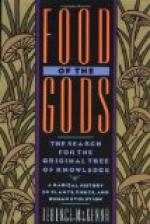In Venezuela an old Spanish custom still prevails of sprinkling a fine red earth over the beans in the process of drying; this plan has little to recommend it, unless it be for the purpose of long storage in warehouses in the tropics, when the “claying” may protect the bean from mildew and preserve the aroma. In Ceylon it is usual to thoroughly wash the beans after the process of fermentation, thus removing all remains of the pulp, and rendering the shell more tender and brittle. Such beans arrive on the market in a more or less broken state, and it seems probable that they are more subject to contamination owing to the thinness of the shell. The best “estate” cocoa from Ceylon has a very bright, clear appearance, and commands a high price on the London market; this cocoa is of the pure criollo strain, light brown (pale burnt sienna) in colour.
[Illustration—Colour Plate: CACAO TREE AND SEEDLING]
The valleys of Trinidad and Grenada have grown cocoa for upwards of a hundred years, but up to the present time very little in the way of manuring has been done beyond the natural vegetable deposits of the forest. In many estates of recent years cattle have been quartered in temporary pens on the hills, moving on month by month, with a large central pen for the stock down on the savanna.
The cocoa-beans are shipped to Europe in bags containing from one to one and a half hundredweight, and are disposed of by the London brokers nearly every Tuesday in the year at a special sale in the Commercial Sale Room in Mincing Lane.
The cacao-tree has sometimes been grown from seed in hot-houses in this country, but always with difficulty, for not only must a mean temperature of at least 80 deg. F. be maintained, but the tree must be shielded from all draught. Among the most successful are the trees grown by Mr. James Epps, Jun., of Norwood, by whose kind permission the accompanying sketches from life were made. Success has only crowned his efforts after many years of patient care. To grow a mere plant was comparatively simple, but to produce even a flower needed long tending, and involved much disappointment; while to secure fruition by cross-fertilization was a still more difficult task, accomplished in England probably on only one other occasion.
FOOTNOTES:
[10] For full information on the subject of planting, see Simmond’s “Tropical Agriculture” (Spon, London and New York); Nicholl’s “Tropical Agriculture” (Macmillan).
[11] See plate facing p. 77.
[12] See frontispiece.
III. ITS MANUFACTURE.
[Illustration—Black and White Plate: Bournville: “The Factory in a Garden.”]
[Illustration—Drawing: “ON ARRIVAL AT THE FACTORY".]




